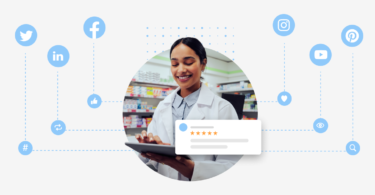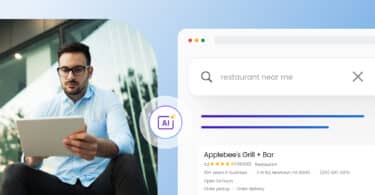Social listening is a powerful strategy that gives businesses direct access to their customers’ voices. This isn’t just another feature of a social media management tool. Beyond tracking mentions, it analyzes discussions around your brand, competitors, and industry, so you gain valuable insights to adjust strategies and identify opportunities even when you’re not explicitly tagged.
With digital conversations shaping customer expectations, the ability to listen effectively can set your business apart. This blog dives into how social listening works, showcasing successful brand examples and providing actionable steps to seamlessly integrate it into your business strategy.
Pro perspective 💡
Social listening bridges the gap between what customers say and what they need. It reveals the deeper "why" behind conversations, helping businesses enhance customer experiences, and build strategies rooted in real-world insights. This isn’t just listening—it’s foresight in action.
Table of contents
- What is social listening?
- Why is social listening important?
- How does social listening differ from social monitoring?
- Who needs social listening?
- How does social listening work?
- Top ways companies use social listening
- Challenges and solutions in social media listening
- 3 unqiue tips and tricks of using social listening
- How to create a social listening strategy?
- Common errors to avoid when doing social listening
- Frequently asked questions about social listening
- Consider Birdeye Social AI for a 360° social media management
What is social listening?
Social listening refers to observing conversations about your brand, product, or industry across social media channels. It’s more than simply tracking mentions; it’s about analyzing social conversations to gain actionable insights.
Businesses use social listening tools to identify trends, monitor brand mentions, and understand customer sentiment on platforms like X, Facebook, and Instagram.
Unlike social media monitoring, which focuses on responding to individual comments, social listening provides a broader view of what people say about your brand. It enables companies to track relevant conversations, measure brand sentiment, and perform sentiment analysis to uncover both positive feedback and negative sentiment.
With this kind of analysis, businesses can fine-tune their social listening strategy to improve the customer experience and enhance brand perception.
By utilizing social listening tools, you can transform social media data into meaningful insights that drive decision-making and align with your business goals.
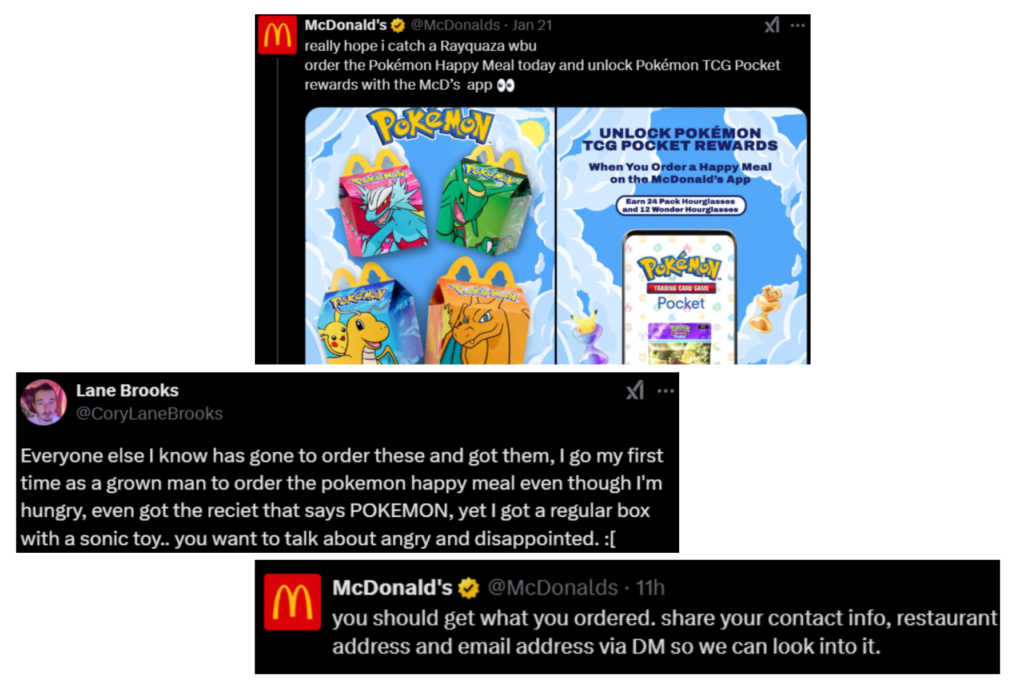
Why is social listening important?
In an era where online conversations influence buying decisions, social listening has become a cornerstone for businesses striving to stay relevant. By analyzing discussions across social media channels, brands can uncover hidden opportunities, respond to challenges, and create strategies backed by actionable insights.
This practice goes beyond simply tracking mentions—it transforms data into powerful tools for decision-making, allowing businesses to adapt, grow, and thrive.
Below, we’ll explore the key reasons why social listening matters, from its tangible business benefits to its ability to reshape the customer experience.
Benefits of social media listening and business impact
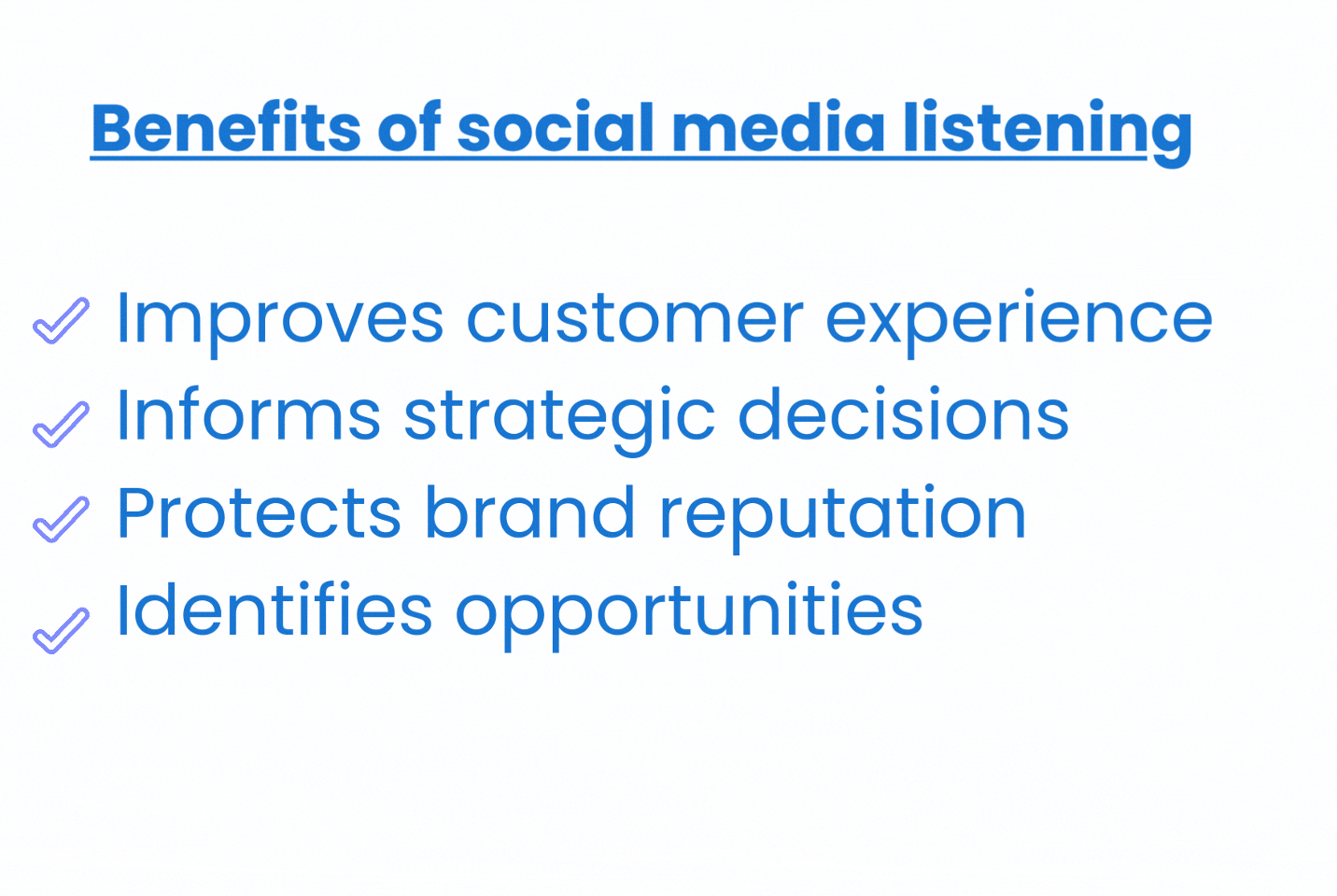
The benefits of social media listening go far beyond customer service. It’s a powerful tool that impacts multiple facets of a business, from marketing to innovation. Here’s how:
- Improved brand health and perception: By monitoring brand sentiment and identifying negative comments, businesses can gauge their audience’s true feelings about their offerings. This helps refine strategies and protect a brand’s reputation.
- Staying ahead of market trends: Understanding industry trends and market trends enables brands to anticipate customer needs and pivot quickly to meet them. This keeps businesses one step ahead of competitors.
- Competitive analysis: With social listening tools, brands can track key influencers, measure competitor activity, and adjust their strategies to outperform rivals.
- Enhanced decision-making: Data from social media analytics provides insights that influence product development, campaign planning, and messaging. This ensures decisions are driven by real customer needs rather than assumptions.
ROI of social listening
Investing in social listening tools isn’t just about tracking conversations; it delivers measurable returns for your business:
- Cost savings: Early detection of potential crises through crisis management tools can prevent costly PR disasters. By addressing issues early, businesses save resources while protecting their reputation.
- Revenue growth: Identifying relevant keywords and trends allows brands to align offerings with customer demand, boosting sales and increasing conversions.
- Improved marketing efficiency: Analyzing social media data helps businesses allocate budgets more effectively, ensuring that campaigns target the right audience with the right message.
- Enhanced retention and loyalty: By acting on meaningful insights gathered from customer feedback, companies can create better experiences that drive repeat business.
Impact of social media listening on business decisions
The role of social media listening in business decisions is transformative, offering clarity and confidence in key areas:
- Insights from social conversations uncover unmet customer needs, inspiring new product ideas or improving existing ones.
- Monitoring social media marketing performance helps fine-tune campaigns in real time, ensuring they resonate with the target audience.
- Sentiment analysis flags potential risks early, enabling teams to proactively manage issues before they escalate.
- Sharing insights from social listening data can help teams from marketing, sales, and customer support collaborate more effectively.
How does social media listening improve customer experience?
Delivering an exceptional customer experience starts with understanding what customers truly want. Here’s how social media listening makes this possible:
- Personalized engagement: By analyzing brand mentions, companies can identify and address individual needs, building stronger relationships with customers.
- Proactive problem-solving: Monitoring negative sentiment allows businesses to address pain points before they become major issues, creating a smoother experience for customers.
- Tailored marketing: Insights from social media analytics help personalize campaigns, making customers feel heard and valued.
- Continuous improvement: Feedback gathered through listening tools informs operational changes that directly enhance the customer journey.
How does social listening differ from social monitoring?
Social listening and social media monitoring are often confused, but they serve distinct purposes in how businesses understand and engage. Both involve tracking what people say about a brand or product, but their scope and outcomes vary significantly.
While social media monitoring tools focus on real-time responses and immediate action, social listening delves deeper, analyzing social data to uncover trends, patterns, and insights that guide long-term strategies.

Let’s understand the difference is crucial for businesses that balance proactive engagement with actionable intelligence.
Focus: Monitoring conversations vs. extracting insights
- Social media monitoring focuses on responding to customer conversations in real-time, addressing questions, complaints, and other direct interactions.
- Social listening identifies broader themes, from analyzing social data to generating social listening insights that drive innovation and strategy.
Purpose: Reactive vs. proactive
- Social monitoring is reactive, helping brands respond to issues like negative comments or questions as they arise.
- Social listening is proactive, leveraging advanced social listening tools to predict trends, understand brand perception, and improve the overall customer experience.
Scope: Micro vs. macro
- Social monitoring provides a narrow view, helping businesses track social media accounts or specific interactions.
- Social listening offers a macro perspective, analyzing social media channels and social conversations to uncover patterns and opportunities.
Stakeholders: Customer-facing vs. strategy-focused
- Social monitoring benefits teams like the customer service team, enabling direct engagement with customers.
- Social media listening supports broader organizational goals, aligning insights with key metrics for marketing, product development, and leadership teams.
Who needs social listening?
Social listening isn’t just for every business—it’s particularly vital for brands that rely heavily on social media to connect with their audience. Here are the ideal candidates for implementing social listening:
1. Large consumer brands
Brands like Southwest Airlines or Starbucks need social listening to manage massive volumes of customer conversations happening daily. From monitoring brand sentiment to addressing complaints in real-time, these brands rely on insights to improve customer satisfaction and build loyalty.
2. B2B brands leveraging social media for engagement
For B2B brands like AT&T, where customer service and reputation play critical roles, social listening helps identify recurring pain points, track industry trends, and improve support channels. Insights from social listening tools can shape messaging and even product roadmaps.
3. Brands in competitive industries
In industries like telecom, hospitality, or retail, where competition is fierce, social listening provides a strategic edge. These brands can use it to analyze competitors’ strategies, spot market gaps, and refine their offerings to stay ahead.
How does social listening work?
Social listening involves more than tracking mentions—analyzing online conversations around your brand, competitors, and industry. Businesses use social listening tools to collect data from social media channels, forums, and reviews to identify trends, measure sentiment, and uncover actionable insights. This process helps businesses refine strategies and adapt to customer needs.
Listening alone won’t drive results: Here’s how Birdeye manages it all
While social listening provides valuable insights, it’s only one part of the broader social media management puzzle. Successful brands don’t just listen—they act. That’s where tools like Birdeye Social AI work.
Birdeye’s social media management software goes beyond just listening by focusing on social media management—responding to customer reviews, engaging on multiple platforms, and ensuring your brand stays proactive.
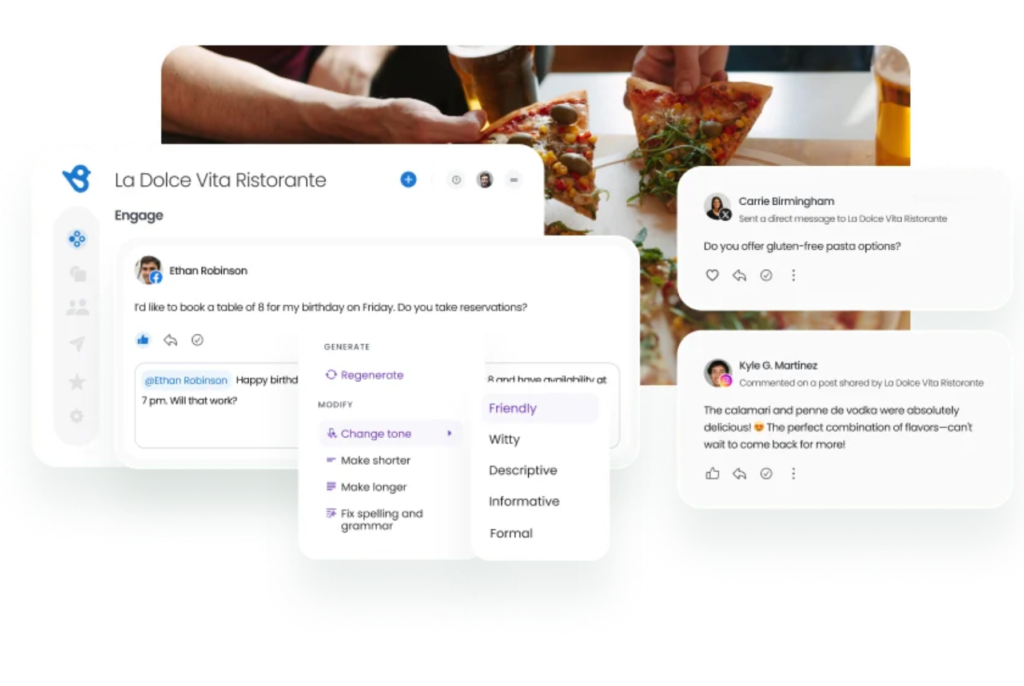
Instead of just analyzing conversations, Birdeye helps businesses turn every interaction into an opportunity to build stronger relationships and improve customer satisfaction.
Sometimes, it’s not just about listening—it’s about acting, and that’s where Birdeye Social excels.
Top ways companies use social listening
Social listening is an essential tool for companies across industries. It enables them to tap into social media data, identify opportunities, and address challenges proactively. Below are the most impactful ways businesses use this strategy to stay competitive and connected to their audience.
1. Gauge sentiment
Understanding public perception is crucial to identifying whether discussions around their brand or products are positive, negative, or neutral. This insight guides marketing strategies and protects brand health.
Chipotle changed its Twitter handle to “Chicotle” after BTS member Jungkook’s viral mispronunciation
Chipotle showcased its mastery of social listening by capitalizing on a viral moment involving BTS member Jungkook. In January 2022, Jungkook mispronounced “Chipotle” as “Chicotle” in a YouTube video that quickly garnered over 4 million views. Fans celebrated the playful moment, creating a wave of positive sentiment online.

In response, Chipotle changed its name on Twitter to “Chicotle” and updated its header image to reflect the mispronunciation, further engaging with BTS fans.
By tracking real-time sentiment and leveraging this cultural moment, Chipotle not only amplified the buzz but also deepened its connection with younger audiences and the global BTS fandom.
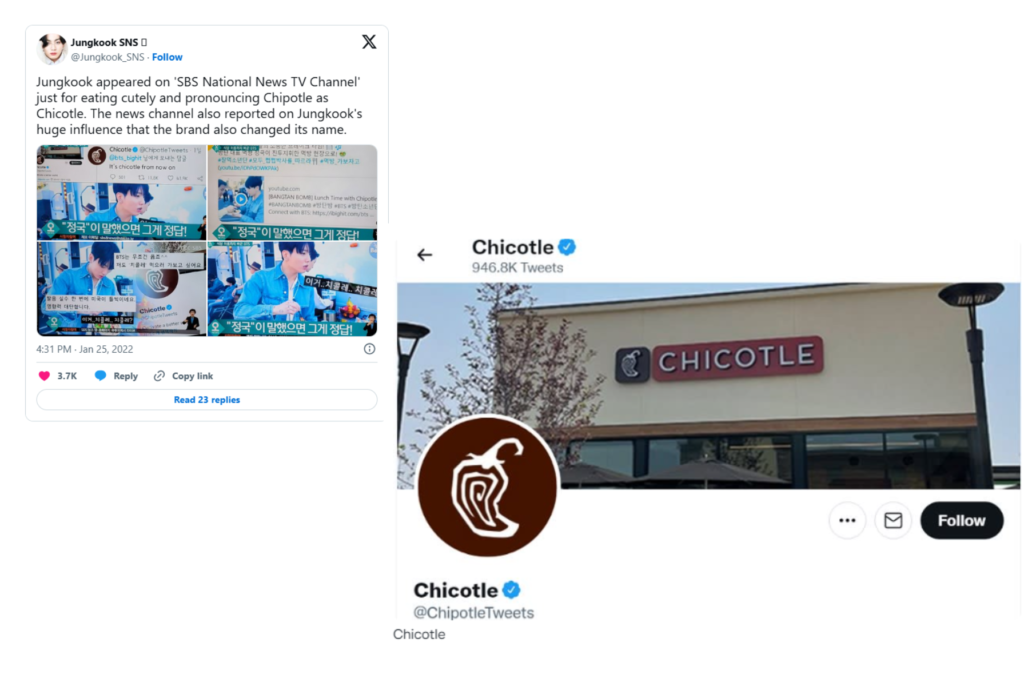
2. Identifying emerging trends
Tracking industry trends and the latest social media trends gives brands the foresight to adapt their offerings or messaging to align with customer expectations. Companies use social listening insights to recognize evolving needs, ensuring they stay ahead in competitive markets.
From customer’s car fire to viral fame: How Stanley won hearts
In 2023, Stanley demonstrated the power of brand health monitoring through a viral TikTok video showcasing a Stanley mug surviving a car fire with ice still intact. The video amassed over 95.4 million views, sparking significant social media buzz.
Recognizing the moment, Stanley’s President responded personally, offering to replace the user’s car. Isn’t it a great marketing strategy? This thoughtful engagement not only generated 21.8k additional mentions but also reinforced Stanley’s reputation as a customer-centric brand.
It exemplifies the emerging trend of brands leveraging viral moments to build trust with their audience.
3. Competitor analysis
Monitoring competitors’ social media presence and social conversations reveals valuable insights. Companies can identify competitor weaknesses, leverage strengths, and fine-tune their social media strategy by understanding their rival’s social media campaigns.
Samsung turns Apple’s loss into its gain
After Apple’s “Crush” iPad ad received backlash in 2023, Samsung monitored social media conversations to identify customer dissatisfaction. They quickly launched a humorous counter-ad, capitalizing on the viral moment and drawing attention to their own product’s strengths.
We would never crush creativity. #UnCrush pic.twitter.com/qvlUqbRlnE
— Samsung Mobile US (@SamsungMobileUS) May 15, 2024
4. Better customer service
Proactively addressing customer pain points highlighted in consumer conversations can elevate your customer service. Businesses track negative customer reviews and resolve them quickly, ensuring a seamless customer experience while showcasing their dedication to improvement.
McDonald’s listened to customer cravings in Canada
In 2024, McDonald’s Canada monitored customer conversations about missing out on the Grimace Shake craze. They responded by introducing the product to the Canadian market, boosting customer satisfaction and brand sentiment.

Dollar Drink Days and Grimace shakes in the same week? @McDonaldsCanada is really spoiling me.
— Jonathan Chan (@JChan_811) May 15, 2024
5. Brand health monitoring
Maintaining a strong reputation is critical. Social media monitoring tools allow businesses to keep an eye on brand perception, ensuring any issues affecting brand health are addressed promptly.
Lyft saves the day, wins hearts
In September 2023, Lyft quickly responded to a viral post about a customer’s missing cat during a ride. By tracking the conversation, they resolved the situation publicly, ensuring positive sentiment and reinforcing trust.
@AskLyft My Lyft driver drove off with my pet cat still in the car.
— palash pandey (@palashp40616755) September 30, 2023
I was taking my cat to a vet appointment, I was sitting behind the driver and had the cat carrier on the floor of the passenger side back seat.
This example emphasizes how social listening empowered Lyft to address customer issues promptly and improve its social media reputation management.
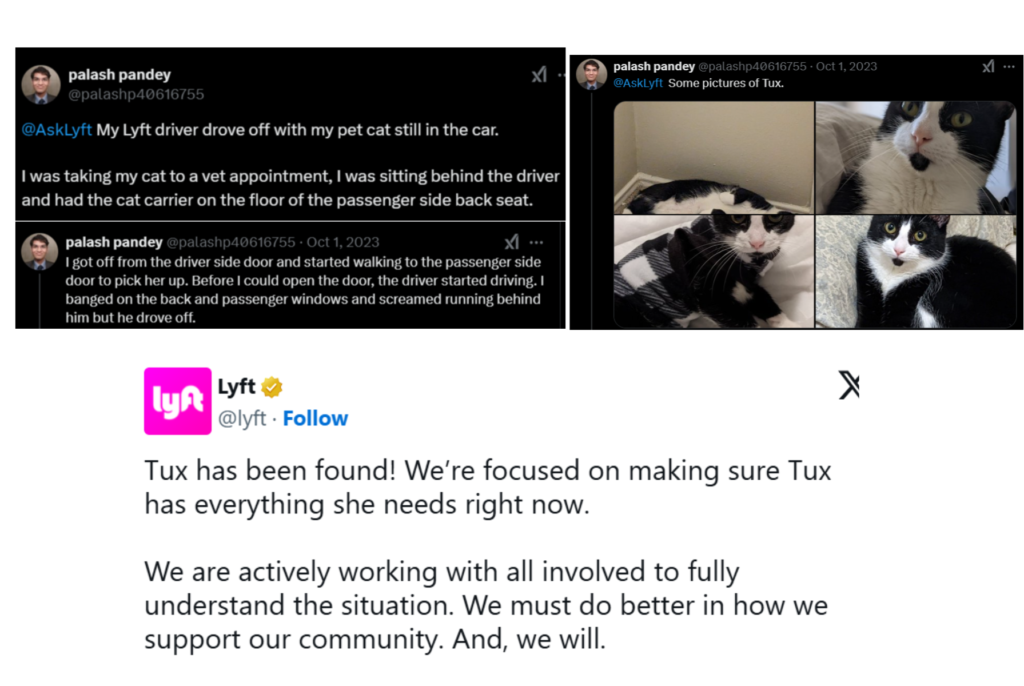
6. Crisis management
Advanced social listening tools act as an early warning system, detecting potential crises before they escalate. Whether it’s negative PR or a social backlash, having a strategy informed by social listening insights can mitigate damage effectively.
Airbnb Turned a scandal into goodwill
When influencer Alix Earle shared her experience of being scammed by a fake Airbnb listing, the brand quickly intervened. They provided a new rental and engaged with her 6M+ followers on TikTok, turning the incident into a story of excellent customer care.
Here’s a genius social play from @AirBNB.
— Jack Appleby (@jappleby) May 24, 2023
Alix Earle (5.3M TikTok subs) went viral when the house she booked in Italy was a scam.@AirBNB saw it, then hooked her + friends up with a huge villa.
So Alix made an amazing TikTok thanking AirBNB: 1.7 million views in 4 hours. pic.twitter.com/JdnXS39eu5
7. Campaign performance tracking
Tracking the performance of social media marketing campaigns helps businesses measure ROI and refine future strategies. Insights from social media analytics ensure campaigns are resonating with the right audience.
Netflix tracks TikTok buzz and leverages ‘Wednesday’s’ viral dance
Netflix tracked the viral popularity of the dance scene from the show “Wednesday” on TikTok. They used this insight to fuel further promotions, including featuring user-generated content and releasing themed merchandise, driving engagement and subscriptions.
Challenges and solutions in social media listening
While social media listening offers powerful insights, businesses often face challenges in implementing it effectively. Here are the most critical hurdles and how to use this social data efficiently:
1. Challenge: Data overload management
Solution: Use advanced social listening tools with AI-powered filters to prioritize relevant mentions, keywords, and trends. Focus on metrics that align with your business goals.
2. Challenge: Real-time analysis
Solution: Automate notifications for spikes in activity or key mentions using listening tools, ensuring rapid responses to time-sensitive issues.
3. Challenge: Privacy and compliance concerns especially with regulations like GDPR or CCPA
Solution: Choose tools that anonymize personal data and ensure compliance. Train teams on ethical data use and privacy standards.
4. Cross-functional collaboration gaps
Solution: Create centralized dashboards and workflows to share findings with relevant teams, such as marketing, customer service, and product development.
Manage Posts, Reputation, and Reporting across Locations
Want to see the impact of Birdeye on your business? Watch the Free Demo Now.
3 unqiue tips and tricks of using social listening
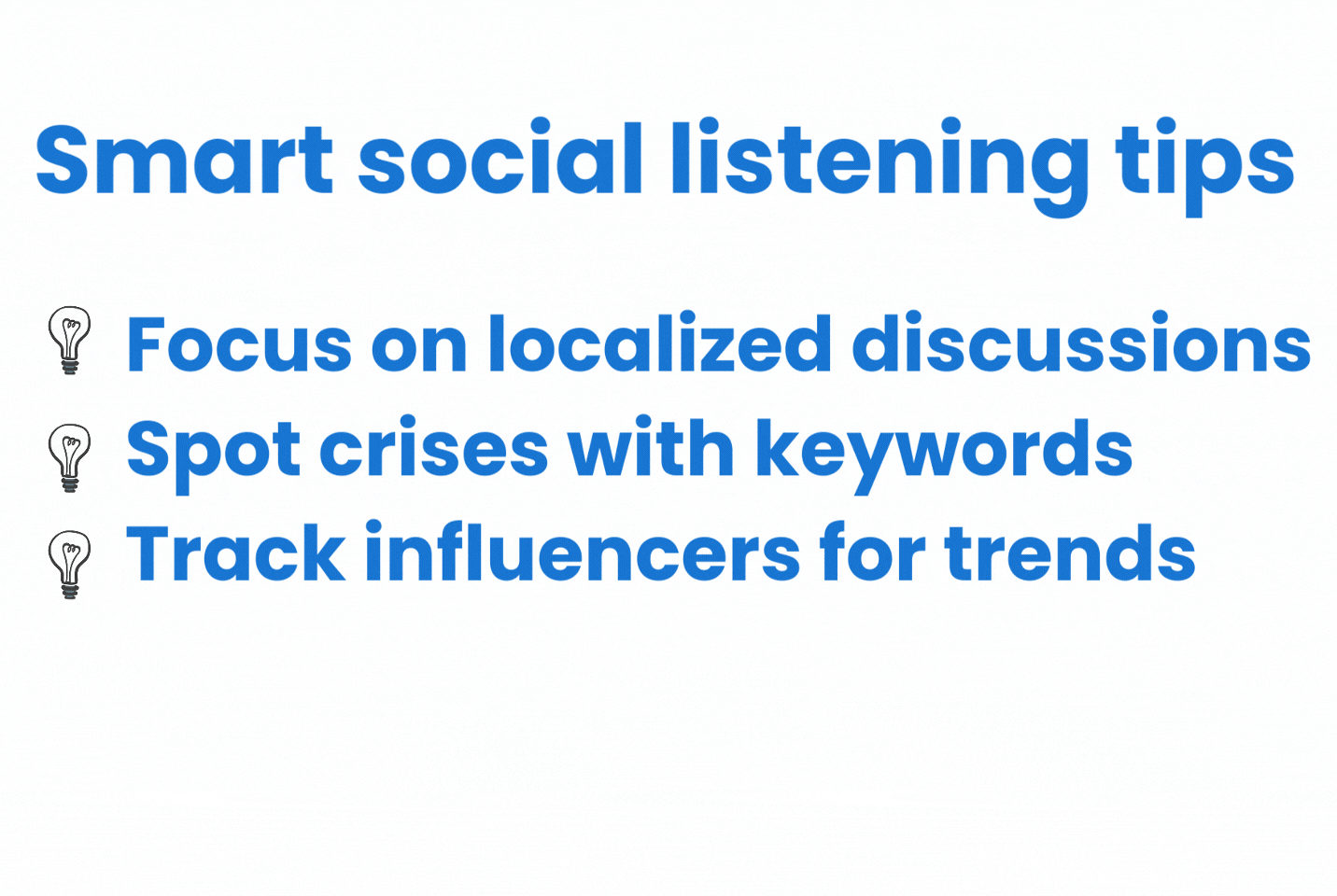
To get the most out of your social listening tools, here are lesser-discussed but highly impactful approaches to elevate your strategy:
1. Explore cultural and regional nuances
Social conversations vary greatly by region and culture. Go beyond global trends and focus on localized discussions. Tailoring campaigns based on cultural preferences or regional pain points that acutely resonates with your audience. This greatly improves your global marketing strategy.
2. Migitate a crisis with relevant keywords before it happens
Instead of simply responding to crises, use sentiment analysis and keyword trends to spot potential issues before they escalate. For example, a sudden spike in complaints about a specific product feature can help you proactively address the issue before it becomes a PR disaster.
3. Monitor influencers to spot new opportunities
Influencers often lead emerging trends or shape conversations about brands and industries. Track discussions around key influencers in your niche to identify potential collaborations or to keep tabs on how your audience responds to their opinions.
How to create a social listening strategy?
An effective social listening strategy is cyclical, evolving as businesses gather, analyze, and act on insights. And creating a social media listening strategy is essential for businesses aiming to extract meaningful value from social listening tools.
A well-defined strategy ensures you address pain points of people talking based on gathered insights and that your efforts are aligned with your goals. Here’s how to strategize:
1. Set clear goals and outcomes
Clarify your objectives, such as enhancing brand sentiment, uncovering industry trends, or driving better customer experiences. Ensure each goal directly supports measurable business outcomes.
2. Choose the right social listening tool
Use social media listening tools to track people talking about your brand across platforms like Twitter, LinkedIn, and even niche communities, ensuring you never miss an important discussion about your target audience.
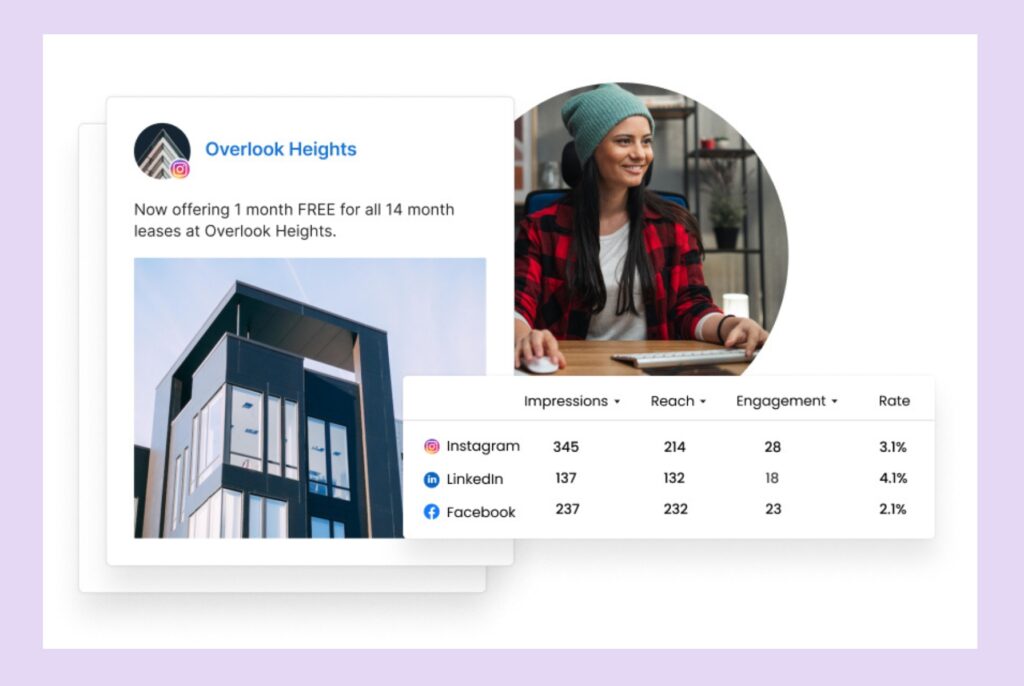
3. Identify key topics, themes, and keywords
Focus on high-value topics by identifying buzzwords and branded or competitor-related hashtags that shape industry discussions.
4. Build workflows for actionable results
Create SOPs that allow insights to be distributed to the right teams—marketing, product development, or customer service—so every insight drives meaningful actions.
5. Review and refine your strategy regularly
Social listening isn’t static. Evaluate performance metrics, refine tools, and update your focus areas to adapt to shifting audience behaviors and trends.
To build or refine your own social listening strategy, ask yourself:
- Are you focused on improving brand sentiment, tracking competitor analysis, or identifying industry trends?
- Are you monitoring keywords, social conversations, and competitor mentions?
- Do you have workflows in place to address negative sentiment or capitalize on positive trends before they lose impact?
- How effectively are you sharing insights with relevant teams like marketing, product development, and customer support?
Let’s explore an example that shows how setting clear goals, using the right tools, and acting on insights can lead to success.
Netflix’s ‘Wednesday’ campaign success
Netflix proved the power of an effective social listening strategy during the promotion of its hit show Wednesday. By monitoring TikTok, Netflix identified the viral buzz around the show’s dance scene. This social listening data helped the team double down on promoting user-generated content and releasing merchandise related to the dance.
Netflix even created a Twitter account handled by Wednesday Addams, the protagonist herself. Their approach highlights key aspects of a strong social listening strategy:
- Clear goals: Boost engagement and subscriptions through viral content.
- Right tools: Use social media listening tools to track mentions, hashtags, and customer sentiment.
- Actionable results: Leverage insights to refine marketing campaigns in real-time.
Common errors to avoid when doing social listening
Even the best social listening strategies can falter when common mistakes are made. Avoid these pitfalls to ensure your efforts deliver meaningful results:
1. Neglecting to act on insights gathered
How to avoid: Establish workflows for acting on insights and assign clear responsibilities across teams.
2. Relying on incomplete or irrelevant data
How to avoid: Regularly audit your social listening tools and expand data sources to capture a comprehensive view.
3. Overlooking competitors’ strategies
Include competitors in your monitoring setup to understand their strengths, weaknesses, and customer perceptions.
4. Failing to integrate listening with monitoring
Integrate both into a unified strategy as monitoring informs immediate actions, and listening guides long-term decisions.
5. Ignoring emerging platforms
Regularly evaluate where your audience is most active and update your tools to monitor these spaces effectively.
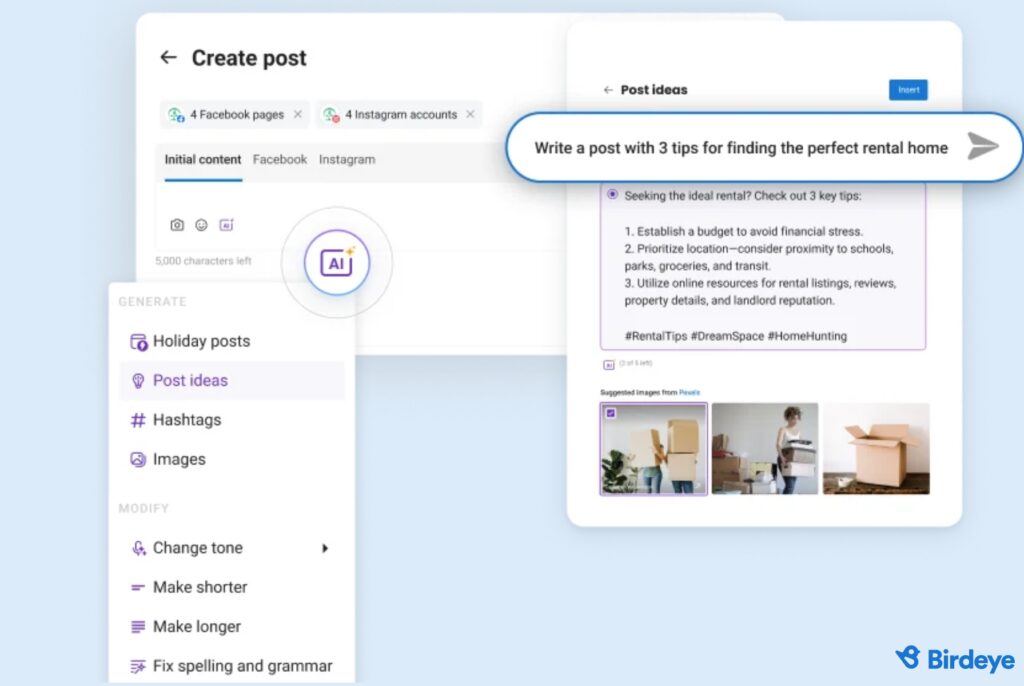
Frequently asked questions about social listening
Social listening examples include tracking customer sentiment, monitoring conversations for brand mentions, identifying popular topics of discussion related to a business, and understanding how people are responding to competitors in the industry.
Social listening tools are software applications that collect and analyze data from online platforms to allow companies to monitor their brand reputation and customer conversations. These tools provide insights into public opinion of the brand by tracking keywords related to the company’s products or services.
The importance of social listening is that it allows companies to gain a better perspective on how people perceive their brand and provides valuable insights into customer preferences.
Social listening is measured using metrics and techniques such as the number of mentions, sentiment analysis, audience demographics, and engagement levels. Social media listening tools can help measure how often certain topics or keywords are mentioned across all digital channels.
Three social listening benefits include: gaining valuable customer insights, understanding the competition better, and creating more effective marketing campaigns.
Consider Birdeye Social AI for a 360° social media management
Most businesses spread out over multiple social media platforms so that they can reach their customers anywhere. This can be overwhelming and time-consuming for companies managing multiple accounts for multiple locations.
With Birdeye Social AI, you can funnel all your social media conversations into one, easy-to-use platform. Schedule some time and speak to one of our experts today to learn more.

This blog post is part of our Social Media Management Guide
Originally published


